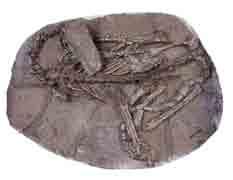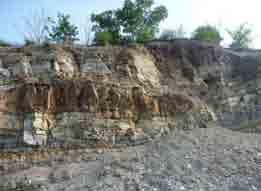
2 minute read
On the record Comings and goings at the Museum

Above left
This specimen of Dilong is interesting because it shows the tyrannosaur in a bird-like sleeping position with forelimbs tucked. It was probably awoken by poisonous volcanic gases or asphyxiated in its sleep to become frozen in time. Photo courtesy Beijing Museum of Natural History.
Above right
The large volcanic (basalt) intrusion at this site was taken near the collection site for the Dilong specimen. It emphasises the key role vulcanism played in the preservation of death assemblages. Photo © Anne Musser.
Above
Albertosaurus lived in western North America during the Late Cretaceous period, about 70 million years ago. Photo © Taylor Made Fossils. early tyrannosaurs have been found in recent years – a delightful cross-cultural experience, complete with banquets at every opportunity! The Chinese people are very proud of their dinosaurian heritage, and there were regional museums in every town we visited. A highlight was the Beipiao Museum of Natural History in Liaoning Province where numerous feathered dinosaurs and fossilised trees have been found. The museum is near the discovery site of the early tyrannosaur Dilong paradoxus. The exhibition features one of the BMNH Dilong specimens – the complete skeleton of a beautiful but deadly little predator just over a metre and a half long when grown. It was preserved as it died, in death position, giving us a tantalising glimpse of the lives and deaths of these fierce carnivores. I went on to Mongolia as a solo traveller and spent two long days at the Museum of Natural History in Ulan Baatar, where original fossil material from the Late Cretaceous of Mongolia is displayed for the public. The massive Asian tyrannosaur Tarbosaurus, almost equal in size to T. rex, is centre stage in the hall of dinosaurs. Many other unique dinosaurs are exhibited, including the tiny, bird- like, one-fingered Mononykus. Several of the specimens were preserved after being buried alive by sandstorms. Particularly evocative is a specimen of the tiny ceratopsian Psittacosaurus, which was fossilised in death position, its head raised as if breathing its last.
FUSS
The UK trip brought me to the Isle of Wight in the south of England, to meet with Wight palaeontologists and visit the locality where the early tyrannosaur Eotyrannus was found. I also visited the Oxford Museum of Natural History, whose collection is famous for a very different and more recent extinct animal: the dodo, the only known specimen preserved with skin intact. There I was shown the partial skeleton of a Jurassic tyrannosaur from England, Juratyrant, just described as a new species in 2012. As I travelled and read, I found myself constantly surprised at the long and dramatic history of this iconic dinosaur group. As a mammal palaeontologist, I must admit that before this project I could not quite understand what all the dinosaurian fuss was about. But I am now a convert – boy, they were cool! And tyrannosaurs? The coolest! I am astounded by their sheer scale – stand next to Scotty and you will see what I mean. I was charmed by the unexpected feathery coat on little Dilong. There were so many different species, over twenty now known, and all of these feature in the Tyrannosaurs exhibition. Now we just need to keep pace with new discoveries, which are sure to continue!
DR ANNE MUSSER PALAEONTOLOGIST
Tyrannosaurs: meet the family opens exclusively at the Australian Museum on 23 November. Beat the crowds – pre-book your tickets at ticketek.com.au/tyrannosaurs.










